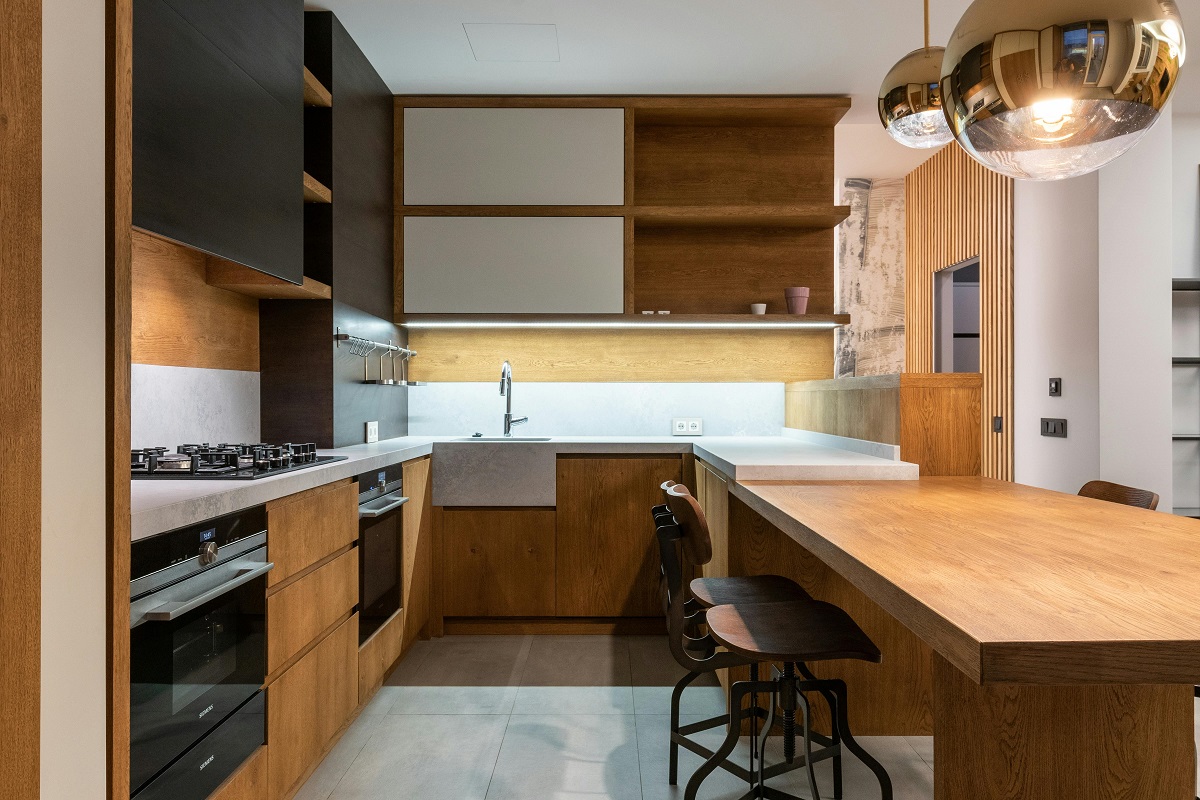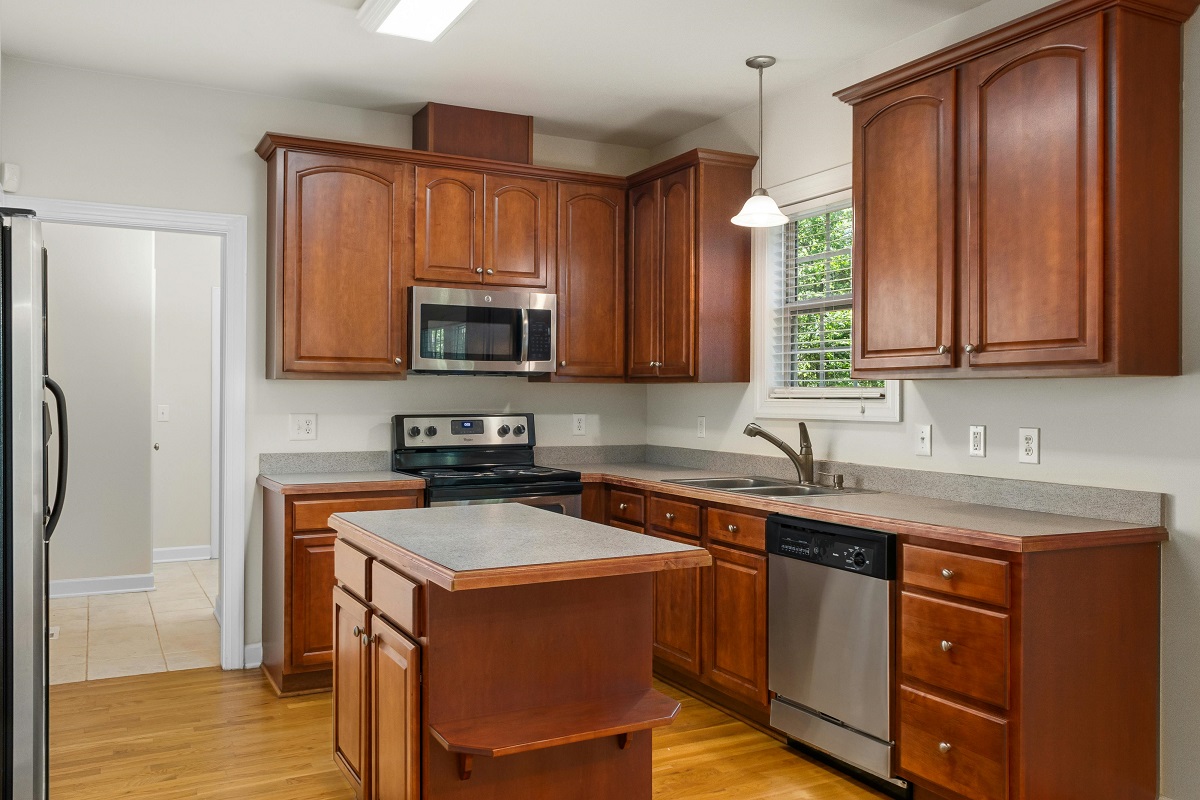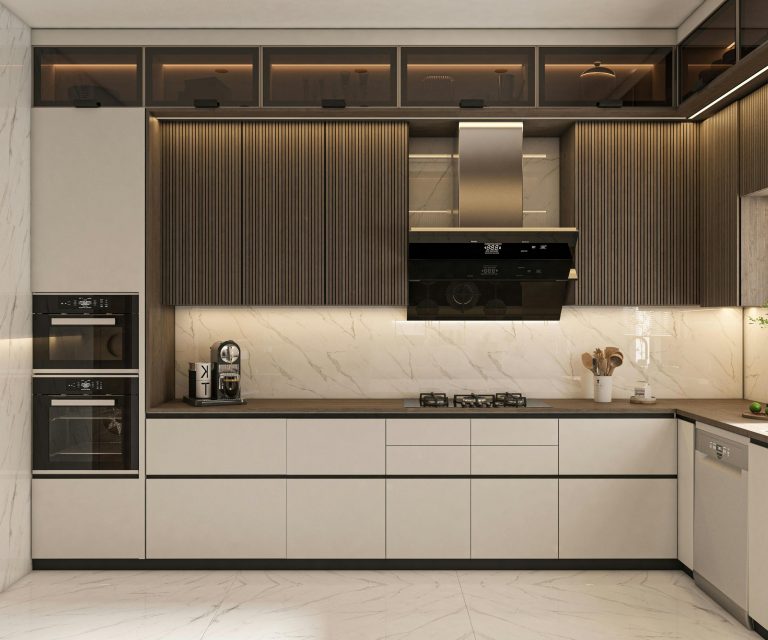

- Plan carefully and set a realistic budget: Proper planning ensures your remodel stays on track and avoids overspending.
- Prioritize essential upgrades: Focus on the elements that will have the biggest impact on both style and functionality, such as cabinetry, lighting, countertops, and storage solutions.
- Maximize space efficiently: Use vertical storage, pull-out solutions, corner storage, compact appliances, and multipurpose furniture to make the most of a small kitchen.
- Achieve style on a budget: Simple updates like painting cabinets, adding open shelving, upgrading hardware, improving lighting, and DIY projects can dramatically improve the space.
- Hire professionals when needed: Certain tasks, such as precise installations or specialized work, are best handled by experts to ensure safety and quality.
- Maintain your kitchen regularly: Routine cleaning, organizing, updating décor, and checking fixtures and hardware keeps your kitchen looking fresh and functional over time.
Remodeling a small kitchen can feel overwhelming. Limited space, tight budgets, and the desire for a stylish, functional area often create a challenge. The good news is that small kitchen remodeling doesn’t have to break the bank. With careful planning, creativity, and smart choices, you can transform your compact kitchen into a space that feels modern, spacious, and highly functional.
This article will explore practical tips for budget-friendly small kitchen remodeling, stylish upgrades, and strategies to maximize both space and design impact.
Why Consider Small Kitchen Remodeling?
Small kitchen remodeling may seem like a luxury, but it can significantly improve your home’s comfort and value. Whether you cook frequently or just need a functional space for daily meals, a well-planned remodel offers several advantages:
- Improved functionality: Reorganizing layout and storage ensures everything you need is within easy reach.
- Increased home value: Even minor updates like cabinetry or countertops can boost resale value.
- Aesthetic appeal: A stylish kitchen creates a warm, inviting environment that enhances your entire home.
Understanding the benefits of remodeling can help you stay motivated and focused during the planning and execution stages.
How to Start Your Small Kitchen Remodel Without Overspending

Starting a small kitchen remodel requires careful planning. Jumping in without a clear plan can lead to overspending, mistakes, and frustration. Here’s how to get started on the right foot:
1. Set a realistic budget
Budgeting is the foundation of a successful remodel. Calculate how much you can afford to spend, factoring in materials, labor, and a cushion for unexpected expenses. Considering kitchen remodel costs early allows you to prioritize the most impactful upgrades and prevents overspending on minor details. Remember, a well-planned budget ensures your project is both practical and stylish.
2. Identify must-have upgrades
Not every element in a kitchen needs to be replaced or updated. Make a list of the upgrades that will give you the best balance of style and functionality. This might include:
- Modern cabinet hardware
- Updated lighting fixtures
- Durable countertops
- Smart storage solutions
Prioritizing essential upgrades helps you allocate funds efficiently and ensures your remodel delivers maximum visual and practical impact.
3. Plan the layout
In small kitchens, layout is critical. A smart layout can make even a tiny kitchen feel spacious and efficient. Consider:
- The kitchen work triangle—the optimal distance between stove, sink, and refrigerator.
- Traffic flow, ensuring multiple people can move comfortably.
- Storage optimization—identify wasted vertical or corner space that could be better utilized.
Spending time planning the layout now saves headaches and extra costs later.
Can You Remodel on a Budget Without Compromising Style?
Yes! Remodeling on a budget is not only possible, it can be highly rewarding. With careful choices and creativity, you can achieve a stunning kitchen without overspending. Consider these strategies:
- Paint instead of replace: Fresh paint on cabinets or walls can make a dramatic difference. Light or neutral colors open up space, while bold accent walls add personality.
- Open shelving: Replacing some upper cabinets with open shelves creates an airy, open feel. Plus, it’s easier to access frequently used items.
- Hardware upgrades: Switching out old knobs and handles for modern designs is a simple, inexpensive way to elevate the look.
- Lighting matters: Add under-cabinet lights, pendant lights, or LED strips to brighten workspaces and add a stylish touch.
- DIY where feasible: Installing backsplash tiles, painting, or assembling shelves can save money, but be realistic about your skill level to avoid costly mistakes.
These simple changes can deliver a high-end look while keeping your remodel within budget.
Maximizing Space in a Small Kitchen
Small kitchens often feel cramped, but clever design and storage solutions can make them feel larger and more functional. Here are some practical tips:
- Use vertical space: Taller cabinets or shelves take advantage of height for extra storage.
- Pull-out solutions: Pull-out pantry shelves, spice racks, or utensil drawers make items easily accessible.
- Corner storage: Lazy Susans, rotating shelves, or corner drawers optimize space that is often wasted.
- Compact appliances: Choose smaller appliances that still deliver full functionality without dominating counter space.
- Multipurpose furniture: A kitchen island with built-in storage, a fold-down table, or an extendable countertop can serve multiple functions without overcrowding.
Even small adjustments can significantly improve how your kitchen feels and functions.
Choosing Materials Wisely
The materials you select influence both style and longevity. Choosing wisely can save money while still creating a beautiful kitchen:
- Countertops: Laminate or butcher block is cost-effective, while quartz or granite provides a higher-end look if your budget allows.
- Cabinetry: Stock cabinets are affordable, semi-custom offers flexibility, and fully custom cabinets provide tailored solutions if your budget permits.
- Flooring: Vinyl planks, laminate, and ceramic tiles provide durability without high costs. Consider patterns that visually expand the space.
- Backsplashes: Peel-and-stick tiles or ceramic options are stylish, affordable, and easy to install.
Material decisions affect the look, feel, and long-term performance of your kitchen, so research before committing.
Should You Hire an Expert for Certain Tasks?
While DIY can save money, some tasks are better handled by professionals. Hiring an expert for door installation, for instance, ensures doors fit properly and operate smoothly, preventing costly adjustments later. Similarly, plumbing, electrical work, or gas appliance installation should be completed by licensed professionals to meet safety and code requirements. Choosing the right professional for specialized tasks keeps your remodel safe, efficient, and stress-free.
How to Get the Best Value for Your Kitchen Remodel Costs
Keeping track of kitchen remodel costs doesn’t mean compromising on style. Here’s how to get the most value for your money:
- Compare multiple quotes: Shop around for contractors and suppliers to find competitive prices.
- Reuse where possible: Salvage cabinets, lighting, or hardware when they’re in good condition.
- Time your purchases: Look for clearance items, seasonal sales, and discount programs.
- Focus on impactful upgrades: Spend more on elements that dramatically improve the overall look, such as countertops, cabinet fronts, or lighting.
Strategically spending ensures your kitchen remodel delivers both function and style while staying within budget.
How Can Small Design Changes Make a Big Impact?

Sometimes, subtle changes make the biggest difference:
- Color schemes: Light colors open the space, while bold accents create focal points.
- Reflective surfaces: Mirrors, glossy tiles, and glass-front cabinets increase the sense of depth.
- Streamlined decor: Keeping countertops clutter-free and using minimalistic accessories improves the visual flow.
- Functional accessories: Stylish organizers, trays, and containers keep items accessible and visually tidy.
Even minor updates like these can dramatically improve both the usability and look of your kitchen.
How to Balance Style and Practicality
A small kitchen remodel should strike a balance between aesthetics and usability. Consider these strategies:
- Stick to a cohesive theme: Harmonize colors, materials, and finishes throughout the kitchen.
- Think long-term: Select durable materials that will withstand daily use.
- Prioritize efficiency: Ensure every element contributes to better workflow or storage.
- Incorporate multi-use elements: Foldable tables, pull-out cutting boards, or built-in recycling bins save space and enhance functionality.
By balancing style with practicality, your kitchen will look great and function smoothly for years to come.
Common Mistakes to Avoid in Small Kitchen Remodeling
Being aware of common pitfalls helps you avoid unnecessary expenses and frustration:
- Overcrowding the space with appliances or furniture.
- Ignoring the kitchen work triangle, causing inefficient workflow.
- Choosing low-quality materials that wear quickly.
- Attempting complex DIY tasks like plumbing or electrical work.
- Failing to plan storage before purchasing cabinets or fixtures.
Anticipating these mistakes helps your remodel run smoothly and reduces the risk of costly corrections.
Quick Upgrades That Don’t Break the Bank
If you want noticeable results without a massive investment, try these quick upgrades:
- Swap outdated cabinet hardware.
- Install a new faucet or sink.
- Add a colorful backsplash.
- Paint cabinets or walls.
- Replace outdated lighting fixtures.
Even small updates like these can create a modern, refreshed look without exceeding your budget.
How to Keep Your Small Kitchen Looking Fresh
After the remodel, maintaining your kitchen ensures it stays stylish and functional. A well-kept kitchen not only looks inviting but also makes cooking and cleaning more efficient. Here are some practical tips:
- Regularly declutter countertops: Keep only the essentials out, like your coffee maker or a fruit bowl. Store utensils, appliances, and gadgets in cabinets or drawers to maintain a clean, open look.
- Deep clean appliances, cabinets, and floors: Regular cleaning prevents grease, grime, and dirt from building up. Wipe down cabinet faces, scrub floors, and clean appliances weekly or biweekly depending on usage.
- Refresh paint or hardware periodically: Over time, even small chips or worn handles can make your kitchen feel dated. Touching up paint or swapping cabinet hardware is an easy way to keep your kitchen feeling brand new.
- Update decor to match seasonal trends or personal taste changes: Simple changes like new dish towels, a colorful rug, or seasonal decorations can give your kitchen a fresh look without major investment.
- Rotate and reorganize pantry items: Keeping your pantry organized and rotating items ensures freshness and helps maintain a clean, orderly look. Consider clear containers or labeled bins for a stylish, functional storage solution.
- Maintain your countertops: Depending on your countertop material, follow care instructions to prevent stains, scratches, or water damage. Regularly wiping down and using cutting boards protects the surface.
- Check and maintain lighting: Replace dim bulbs, clean fixtures, and consider upgrading to energy-efficient LEDs. Proper lighting keeps your kitchen bright, welcoming, and easy to work in.
- Inspect cabinet hinges and doors: Over time, hinges may loosen or doors may sag. Tightening screws or adjusting doors ensures everything works smoothly and looks well-maintained.
- Create a weekly or monthly cleaning schedule: Breaking cleaning tasks into manageable chunks prevents buildup and keeps maintenance from feeling overwhelming. A consistent routine is key to a fresh, stylish kitchen.
Routine maintenance ensures that your small kitchen continues to impress long after the remodel, keeping it both functional and beautiful for everyday use.
Final Thoughts
Small kitchen remodeling doesn’t have to be expensive or stressful. By prioritizing impactful upgrades, planning carefully, and making smart material choices, you can create a stylish, functional kitchen without overspending. From maximizing space to focusing on practical yet aesthetic improvements, even a modest remodel can completely transform your kitchen’s look and feel.
Remember, keeping the balance between style, functionality, and budget is the key. With thoughtful planning and a few strategic choices, your small kitchen can become both a beautiful and practical heart of your home.


